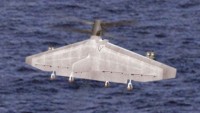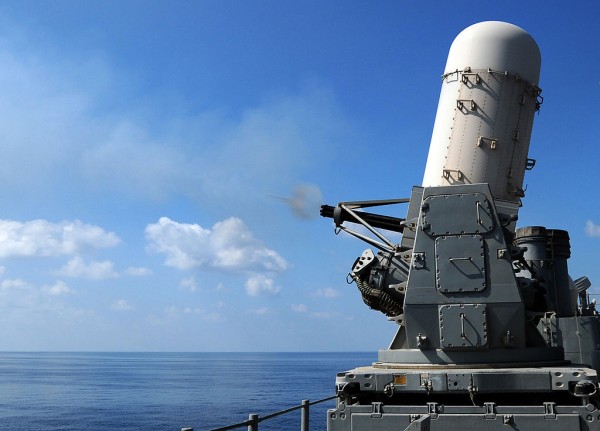DARPA Close to Perfecting Mini-Missiles that can Destroy Drone Swarms
| Arthur Dominic Villasanta | | Jan 18, 2017 09:32 PM EST |
(Photo : U.S. Navy) Phalanx CIWS aboard a U.S. Navy warship fires on a target.
The U.S. Navy is pushing ahead with a program whose aim is to defeat swarm attacks by aerial drones and naval drones by using special "smart mini-missiles" that can destroy these drones en masse.
Swarm attacks by the Russian and Chinese military are inevitable, the Navy believes, and a defense against them must be present aboard warships in harm's way.
Like Us on Facebook
The Navy's "Multi Azimuth Defense Fast Intercept Round Engagement System" (MAD-FIRES) program aims to develop a medium-caliber guided projectile that can be fired from the 20 mm autocannon in a U.S. Navy warship's Phalanx Close-in Weapon System (CIWS), or from any other 20 mm to 40 mm caliber autocannon on a warship.
CIWS is the last line of defense of Navy warships against high-speed threats such as cruise missiles and anti-ship missiles. The Ohalanx 20 mm autocannon unleashes 4,500 rounds per minute from its six barrels. The rounds are tracked by radar, allowing the gun to accurately track and destroy a target.
The MAD-FIRES program is being run by the U.S. Defense Advanced Research Projects Agency (DARPA).
DARPA said MAD-FIRES aims to advance the state-of-the-art in defensive gun systems by creating a new, low-cost technological foundation for guided, gun-launched projectiles. Specifically, MAD-FIRES aims to incorporate enhanced ammunition rounds able to alter their flight path in real time to stay on target, and a capacity to continuously target, track and engage multiple fast-approaching targets simultaneously and re-engage any targets that survive initial engagement.
DARPA says MAD-FIRES will combine the guidance, precision, and accuracy of missiles with the speed, rapid-fire capability, and large ammunition capacity of medium-caliber bullets like 20 mm to 40 mm ammunition designed to destroy lightly armored vehicles, aircraft and personnel.
It noted attacks by unmanned vehicles, missiles, small planes, fast in-shore attack craft and other platforms "pose a perennial, evolving and potentially lethal threat to ships and other maritime vessels.
"The escalating risks posed by these ever-morphing threats demand that vessels have access to defensive capabilities at the leading edge of air and surface combat technologies.
"In particular, current close-range gun systems would greatly benefit from an ability to engage multiple and diverse targets coming from a range of directions and do so rapidly and with high precision."
Prototype MAD-FIRES smart bullets are currently being developed and tested by Raytheon, which received an extra $8 million for this purpose. Raytheon has so far received $27 million to develop MAD-FIRES.
Another major defense contractor, Lockheed Martin, is also expected to receive funding to work on MAD-FIRES.
TagsU.S. Navy, Multi Azimuth Defense Fast Intercept Round Engagement System, MAD-FIRES, Phalanx Close-in Weapon System, CIWS, Defense Advanced Research Projects Agency, DARPA
©2015 Chinatopix All rights reserved. Do not reproduce without permission
 Soft Exosuit will make US Soldiers less Prone to Fatigue; will Complement Bullet-proof TALOS Armor
Soft Exosuit will make US Soldiers less Prone to Fatigue; will Complement Bullet-proof TALOS Armor Over 100 US Navy Warships to become Aircraft Carriers with Deployment of TERN Aerial Drone
Over 100 US Navy Warships to become Aircraft Carriers with Deployment of TERN Aerial Drone Department of Defense Support Key to DARPA Successes
Department of Defense Support Key to DARPA Successes DARPA Pushes Ahead with VTOL Project to Transform US Navy Warships into Aircraft Carriers
DARPA Pushes Ahead with VTOL Project to Transform US Navy Warships into Aircraft Carriers DARPA Making Good Progress in Developing ‘Robotic Co-Pilots’ for US Warplanes
DARPA Making Good Progress in Developing ‘Robotic Co-Pilots’ for US Warplanes
EDITOR'S PICKS
-

Did the Trump administration just announce plans for a trade war with ‘hostile’ China and Russia?
-

US Senate passes Taiwan travel bill slammed by China
-

As Yan Sihong’s family grieves, here are other Chinese students who went missing abroad. Some have never been found
-

Beijing blasts Western critics who ‘smear China’ with the term sharp power
-

China Envoy Seeks to Defuse Tensions With U.S. as a Trade War Brews
-

Singapore's Deputy PM Provides Bitcoin Vote of Confidence Amid China's Blanket Bans
-

China warns investors over risks in overseas virtual currency trading
-

Chinese government most trustworthy: survey
-

Kashima Antlers On Course For Back-To-Back Titles
MOST POPULAR
LATEST NEWS
Zhou Yongkang: China's Former Security Chief Sentenced to Life in Prison

China's former Chief of the Ministry of Public Security, Zhou Yongkang, has been given a life sentence after he was found guilty of abusing his office, bribery and deliberately ... Full Article
TRENDING STORY

China Pork Prices Expected to Stabilize As The Supplies Recover

Elephone P9000 Smartphone is now on Sale on Amazon India

There's a Big Chance Cliffhangers Won't Still Be Resolved When Grey's Anatomy Season 13 Returns

Supreme Court Ruled on Samsung vs Apple Dispute for Patent Infringement

Microsoft Surface Pro 5 Rumors and Release Date: What is the Latest?










